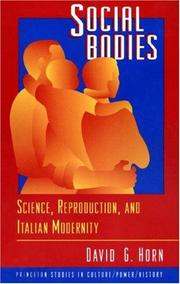| Listing 1 - 3 of 3 |
Sort by
|

ISBN: 0691037213 0691037205 9780691037219 9780691037202 1282752049 1400803810 1400803829 1400821452 9786612752049 9781400803828 9781282752047 9781400821457 Year: 1994 Publisher: Princeton, N.J. : Princeton University Press,
Abstract | Keywords | Export | Availability | Bookmark
 Loading...
Loading...Choose an application
- Reference Manager
- EndNote
- RefWorks (Direct export to RefWorks)
Using as his example post-World War I Italy and the government's interest in the size, growth rate, and "vitality" of its national population, David Horn suggests a genealogy for our present understanding of procreation as a site for technological intervention and political contestation. Social Bodies looks at how population and reproductive bodies came to be the objects of new sciences, technologies, and government policies during this period. It examines the linked scientific constructions of Italian society as a body threatened by the "disease" of infertility, and of women and men as social bodies--located neither in nature nor in the private sphere, but in that modern domain of knowledge and intervention carved out by statistics, sociology, social hygiene, and social work. Situated at the intersection of anthropology, cultural studies, and feminist studies of science, the book explores the interrelated factors that produced the practices of reason we call social science and social planning. David Horn draws on many sources to analyze the discourses and practices of "social experts," the resistance these encountered, and the often unintended effects of the new objectification of bodies and populations. He shows how science, while affirming that maternity was part of woman's "nature," also worked to remove reproduction from the domain of the natural, making it an object of technological intervention. This reconstitution of bodies through the sciences and technologies of the social, Horn argues, continues to have material consequences for women and men throughout the West.
Human body --- Fertility, Human --- Fascism and culture --- Fascism and women --- Human reproductive technology --- Social aspects --- Symbolic aspects --- Government policy --- History --- Italy --- Politics and government --- Fertility [Human ] --- 20th century --- 1914-1945 --- Body, Human - Social aspects - Italy. --- Body, Human - Italy - Symbolic aspects. --- Fertility, Human - Government policy - Italy. --- Fascism and culture - Italy. --- Fascism and women - Italy. --- Human reproductive technology - Italy - History - 20th century. --- Italy - Politics and government - 1914-1945. --- Human body - Social aspects - Italy --- Human body - Symbolic aspects - Italy --- Fertility, Human - Government policy - Italy --- Fascism and culture - Italy --- Fascism and women - Italy --- Human reproductive technology - Italy - History - 20th century --- Italy - Politics and government - 1914-1945

ISBN: 0520242165 1282357905 9786612357909 0520938054 1597346144 9780520938052 058538973X 9780585389738 9780520223639 0520223632 9781282357907 9781597346146 6612357908 9780520242166 Year: 2001 Volume: 42 Publisher: Berkeley : University of California Press,
Abstract | Keywords | Export | Availability | Bookmark
 Loading...
Loading...Choose an application
- Reference Manager
- EndNote
- RefWorks (Direct export to RefWorks)
Ruth Ben-Ghiat's innovative cultural history of Mussolini's dictatorship is a provocative discussion of the meanings of modernity in interwar Italy. Eloquent, pathbreaking, and deft in its use of a broad range of materials, this work argues that fascism appealed to many Italian intellectuals as a new model of modernity that would resolve the contemporary European crisis as well as long-standing problems of the national past. Ben-Ghiat shows that-at a time of fears over the erosion of national and social identities-Mussolini presented fascism as a movement that would allow economic development without harm to social boundaries and national traditions. She demonstrates that although the regime largely failed in its attempts to remake Italians as paragons of a distinctly fascist model of mass society, twenty years of fascism did alter the landscape of Italian cultural life. Among younger intellectuals in particular, the dictatorship left a legacy of practices and attitudes that often continued under different political rubrics after 1945.
Fascism and culture. --- Fascism and culture-- Italy-- History. --- Italy. --- Italy - Politics and government - 1922-1945. --- Fascism and culture --- Fascism --- Regions & Countries - Europe --- Italy --- History & Archaeology --- History --- Politics and government --- Intellectual life --- History. --- Culture and fascism --- Culture --- Fascisme et culture --- Fascisme --- Italie --- Politique et gouvernement --- Vie intellectuelle --- 20th century. --- cultural history. --- dictatorship. --- economic development. --- europe. --- european history. --- fascism. --- fascists. --- historical. --- history of culture. --- history of society. --- history students. --- human condition. --- interwar history. --- italian cinema. --- italian culture. --- italy. --- legacy of fascism. --- model of modern world. --- modern historians. --- modern history. --- modernity. --- mussolini. --- national identity. --- national traditions. --- revolution. --- social boundaries. --- social movements. --- social status.

ISBN: 1282752049 9786612752049 1400821452 1400812119 9781400812110 9781400821457 0691037213 0691037205 9780691037219 9780691037202 1400803829 Year: 1994 Publisher: Princeton, N.J. Princeton University Press
Abstract | Keywords | Export | Availability | Bookmark
 Loading...
Loading...Choose an application
- Reference Manager
- EndNote
- RefWorks (Direct export to RefWorks)
Using as his example post-World War I Italy and the government's interest in the size, growth rate, and "vitality" of its national population, David Horn suggests a genealogy for our present understanding of procreation as a site for technological intervention and political contestation. Social Bodies looks at how population and reproductive bodies came to be the objects of new sciences, technologies, and government policies during this period. It examines the linked scientific constructions of Italian society as a body threatened by the "disease" of infertility, and of women and men as social bodies--located neither in nature nor in the private sphere, but in that modern domain of knowledge and intervention carved out by statistics, sociology, social hygiene, and social work. Situated at the intersection of anthropology, cultural studies, and feminist studies of science, the book explores the interrelated factors that produced the practices of reason we call social science and social planning. David Horn draws on many sources to analyze the discourses and practices of "social experts," the resistance these encountered, and the often unintended effects of the new objectification of bodies and populations. He shows how science, while affirming that maternity was part of woman's "nature," also worked to remove reproduction from the domain of the natural, making it an object of technological intervention. This reconstitution of bodies through the sciences and technologies of the social, Horn argues, continues to have material consequences for women and men throughout the West.
Fascism and culture -- Italy. --- Fascism and women -- Italy. --- Fertility, Human -- Government policy -- Italy. --- Human body -- Social aspects -- Italy. --- Human body -- Symbolic aspects -- Italy. --- Human reproductive technology --Italy -- History -- 20th century. --- Italy -- Politics and government -- 1914-1945. --- Fascism and culture --- Fascism and women --- Fertility, Human --- Human body --- Human reproductive technology --- Italy --- Body, Human --- Human beings --- Body image --- Human anatomy --- Human physiology --- Mind and body --- Human fertility --- Natality --- Demography --- Human reproduction --- Infertility --- Women and fascism --- Women --- Government policy --- Social aspects --- Symbolic aspects --- History --- 20th century. --- Politics and government --- 1914-1945.
| Listing 1 - 3 of 3 |
Sort by
|

 Search
Search Feedback
Feedback About UniCat
About UniCat  Help
Help News
News